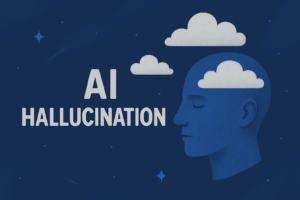AI is no longer the future; it is happening. Every other technology faces issues during its development phase, and AI is no exception. Have you ever asked an AI a question and received an answer that sounded perfectly confident, only to find out it was completely wrong? That is not a glitch; it is called hallucination in the world of AI.
What Are AI Hallucinations?
An AI hallucination occurs when a model produces content that seems accurate but is incorrect, fabricated, illogical, or nonsensical. The result might appear correct, but it’s simply not true, deviating from the fact.
Why do AI Hallucinations Occur?
To understand AI hallucinations, we need to take a look under the hood at how these models are designed, trained, and deployed for customer use.
- Language prediction, not reasoning: Certain generative AIs are just trained to predict the next word in a sentence based on patterns in massive text datasets.
- No awareness: These models lack understanding, but they can only mimic.
- Gaps in training data: If a model has not been exposed to sufficient reliable information, if the training data is biased, or if it has been trained with very limited data, the result may deviate from the actual truth.
- Overconfidence: AI models are optimized for fluency and clarity, which can lead them to present wrong answers in an authoritative tone.
Understand with a Real-World Example
Let us consider the following example. Here, the user asks AI a question and receives a result, then rephrases the question to maintain the same meaning, but this time, AI generates a different answer in contradiction to the previous one. This inconsistency and lack of clarity lead to AI hallucination.
The user asks, “Is Pluto a planet?”
AI says, “Yes, Pluto is the 9th planet.”
The user rephrases the question and asks again, and AI says, “No, Pluto is not a planet since it does not clear its orbital path of other debris.”

AI can hallucinate in terms of fake citations on websites, books, legal or research documents, historical inaccuracies, visual errors in image generation, and contradictory responses, among other issues. In critical fields like banking, healthcare, law, or education, such hallucinations can be lethal.
How to Spot an AI Hallucination
- Check with external authentic sources: If something seems right but still triggers ambiguity, perform a fact-check with authenticated sources, either online or offline.
- Look for vague claims, redundant content, or generic language. If the results are delivered with extreme confidence with oddly precise numbers, it could be a red flag.
- Visit references: If an article or quote is cited, visit the referenced site personally to see if it exists.
How to Mitigate AI Hallucinations
Mitigating AI hallucination involves technical strategies, human oversight, and enhanced system design.

Technical Strategies to Reduce AI Hallucinations
1. Grounding in Reliable Sources
- Involving RAG: It is known as the retrieval-augmented generation approach, used in LLM and NLP. Using this, the machine’s output can be optimized to utilize a retrieval system that refers to an authoritative knowledge data source before producing the result.
- Using APIs: Build external APIs that can query verified external resources or any domain-specific resource in real-time and generate results.
- Guardrails: Building safeguards and including refusal mechanisms when the model is unsure about the context. It can validate the output of the machine and make corrections.
2. Fine-Tuning with Quality Data
- We need to train and then fine-tune the model with an extensive amount of data. Fine-tuning the LLM model can enhance the machine’s performance.
3. Prompt Engineering
- Use properly crafted prompts to enable the model to interpret and understand them, generating factual results.
Human Oversight Can Decrease AI Hallucinations
1. Fact-Checking
- Keep humans in the loop for manually verifying the results generated by an AI model. This can help reduce any false information, which is highly critical in domains such as medical, legal, and financial.
2. User Feedback Loops
- Designing the model to get feedback from the users in terms of emojis, suggestions, comparison between two responses, etc.
- Use reinforcement learning with human feedback (RLHF) to improve truthfulness.
System Design Best Practices to Mitigate AI Hallucinations
1. Audit Trails
- Transparency is key; all significant steps taken to design the model, including all sources and references, should be documented. This ensures compliance and accountability.
2. Confidence Indicators
- Show confidence scores or highlight potentially uncertain outputs to users. A confidence indicator is generally a score that indicates how specific the AI is of the result it has produced, based on which the user can decide whether to rely on or deny it.
3. Regular Evaluation
- Continuously evaluate the model using hallucination tests on various datasets.
4. Use Domain-Specific Models
- Smaller, domain-specific models trained on exclusive data that is authorized can perform well in terms of accuracy.
Conclusion
Fluency cannot be equated with accuracy. As powerful as these tools are, we still require human intervention to maintain their credibility and reliability. The next time you encounter an AI hallucination, be sure to fact-check and appreciate the intriguing complexity of machine-generated imagination.
References
Why IT needs a framework for responsible agentic AI – The Economic Times
Source: Read MoreÂ

